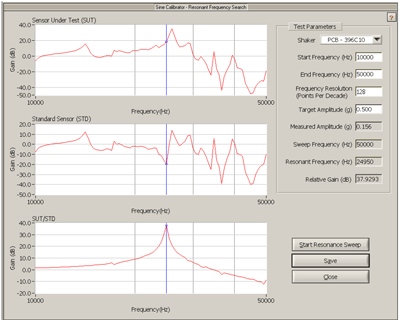Main Menu
- Home
- Product Finder
- Calibration Systems
- Calibration Services
- Digital Sensing
- Industrial Vibration Calibration
- Modal and Vibration Testing
- Non-Destructive Testing
- Sound & Vibration Rental Program
- Learn
- About Us
- Contact Us

Q: I see that the frequency response of the reference standard accelerometer is calibrated up to a 20kHz upper limit frequency. So, how does the resonance search function (up to 50 kHz) for the calibration system “calibrate” the sensitivity at frequencies higher than 20kHz?
A: The answer lies in understanding what is meant by “calibration.” In the normal operating range of 10 Hz to 20 kHz, a standard calibration reports both the properly scaled amplitude at the accurate frequency, which represents the Sensor Under Test (SUT) frequency response function. However, in the case of “resonance search” the goal of the referenced frequency sweep is to ONLY accurately determine the primary mounted resonant frequency of the sensor under test, NOT the sensitivity or scaling of the sensor under test. To accomplish this, as long as the reference sensor response curve is smooth (i.e. behaving with a classic second order, single degree-of-freedom system response and in a frequency range well below its mounted resonance), it is OK that it can and will have some smooth amplitude rise in the reference channel in that higher range from 20 kHz to 50 kHz. This is why the great effort is taken in design and manufacture of the reference accelerometer to ensure that its first mounted resonance is above 70 kHz. By ensuring that we do not approach (and therefore certainly do not cross) the resonance of the reference, then any resonance reported in the sweep is attributable to the mounted response of the SUT. Simply by searching the peak of the frequency response function of the SUT versus the Reference Accelerometer channel, it will accurately provide the SUT mounted resonance.